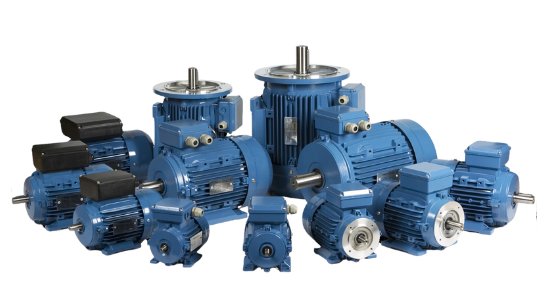The agriculture industry, a cornerstone of global food security, has evolved significantly over the decades. From traditional methods to modern mechanized systems, technology has played a crucial role in increasing productivity and efficiency. Among these innovations, electric motors have emerged as vital components in transforming agricultural practices. They power a range of equipment, enhance precision, and contribute to sustainable farming operations.
In this blog, we’ll explore the impact of electric motors on the agriculture industry and their diverse applications that make modern farming more efficient and eco-friendly.

Impact of Electric Motors in Agriculture
1. Increased Efficiency
Electric motors power various agricultural equipment with unmatched efficiency, enabling farmers to:
- Complete tasks faster, reducing labor intensity.
- Optimize energy usage, lowering operational costs.
2. Enhanced Precision
Electric motors provide precise control over speed, torque, and power, which is essential for:
- Automated irrigation systems.
- Accurate feeding and seeding operations.
3. Energy Sustainability
By utilizing high-efficiency motors and renewable energy sources such as solar and wind, farmers can:
- Reduce dependency on fossil fuels.
- Lower carbon emissions, contributing to sustainable agricultural practices.
4. Durability and Reliability
Modern electric motors are built to withstand the demanding environments of agriculture, including:
- Continuous operation under harsh weather conditions.
- Resistance to dust, moisture, and varying temperatures.
Key Applications of Electric Motors in Agriculture
1. Irrigation Systems
Electric motors drive pumps for irrigation, ensuring consistent and efficient water distribution. Types of systems include:
- Drip Irrigation: Precise delivery of water to plant roots, minimizing waste.
- Sprinkler Systems: Wide coverage of crops for uniform hydration.
- Submersible Pumps: Efficient water extraction from underground sources.
2. Grain Handling and Storage
Motors are crucial for operating equipment like:
- Grain Elevators: Lifting and storing harvested grains.
- Conveyors: Moving grain within silos or processing units.
- Fans for Drying Systems: Removing moisture from stored grains to prevent spoilage.
3. Livestock Management
Electric motors power systems for feeding, milking, and waste management in livestock farming:
- Feed Dispensers: Automated feeding schedules for livestock.
- Milking Machines: Efficient milking processes with minimal labor.
- Ventilation Systems: Maintaining air quality in barns and enclosures.
4. Field Equipment
Motors enhance the functionality of field machinery, including:
- Seeders and Planters: Precise placement of seeds for uniform growth.
- Sprayers: Even application of fertilizers and pesticides.
- Harvesters: Automating the collection of crops.
5. Renewable Energy Integration
Electric motors are integral to renewable energy solutions in agriculture, such as:
- Solar-powered water pumps.
- Wind turbine-driven equipment for remote farms.
Technological Advancements in Electric Motors for Agriculture
1. Smart Motors with IoT
IoT-enabled motors provide farmers with:
- Real-time monitoring of motor performance.
- Automated adjustments to optimize energy use.
- Predictive maintenance alerts to prevent equipment failure.
2. High-Efficiency Motors
Motors with IE3 and IE4 efficiency ratings reduce power consumption, saving energy while maintaining performance.
3. Brushless DC Motors (BLDC)
BLDC motors offer:
- High efficiency and low maintenance.
- Compact designs ideal for small-scale automation.
4. Variable Frequency Drives (VFDs)
VFDs allow motors to adjust their speed and torque based on operational requirements, making them ideal for irrigation and grain handling systems.
Challenges and Solutions
Challenges:
- Initial Investment Costs: Advanced electric motors and automation systems may involve high upfront costs.
- Harsh Operating Conditions: Dust, moisture, and fluctuating temperatures can impact motor performance.
Solutions:
- Lifecycle Savings: Energy-efficient motors offset their initial costs through long-term savings.
- Protective Designs: Enclosures and seals enhance motor durability against environmental challenges.
Benefits of Electric Motors in Agriculture
- Productivity Boost: Automated systems powered by electric motors streamline operations, increasing output.
- Cost Efficiency: Reduced energy consumption and lower maintenance costs lead to significant savings.
- Environmental Sustainability: Electric motors contribute to greener farming practices by enabling renewable energy integration.
- Improved Crop Quality: Precise and consistent operations result in better yields and reduced waste.
Future Trends in Electric Motors for Agriculture
1. Electrification of Farm Machinery
As the industry shifts toward sustainability, electric motors are replacing traditional internal combustion engines in tractors and harvesters.
2. Robotics in Agriculture
Robots powered by electric motors are being increasingly used for tasks like weeding, planting, and monitoring crops.
3. Renewable Energy-Powered Motors
Solar and wind energy systems integrated with electric motors will make farms self-sufficient in energy needs.
Conclusion
Electric motors are revolutionizing the agriculture industry by powering advanced machinery and systems that improve productivity, sustainability, and efficiency. As the sector embraces automation and renewable energy, electric motors will continue to play a vital role in shaping the future of farming.
What are your thoughts on the growing role of electric motors in agriculture? Share your insights below!







